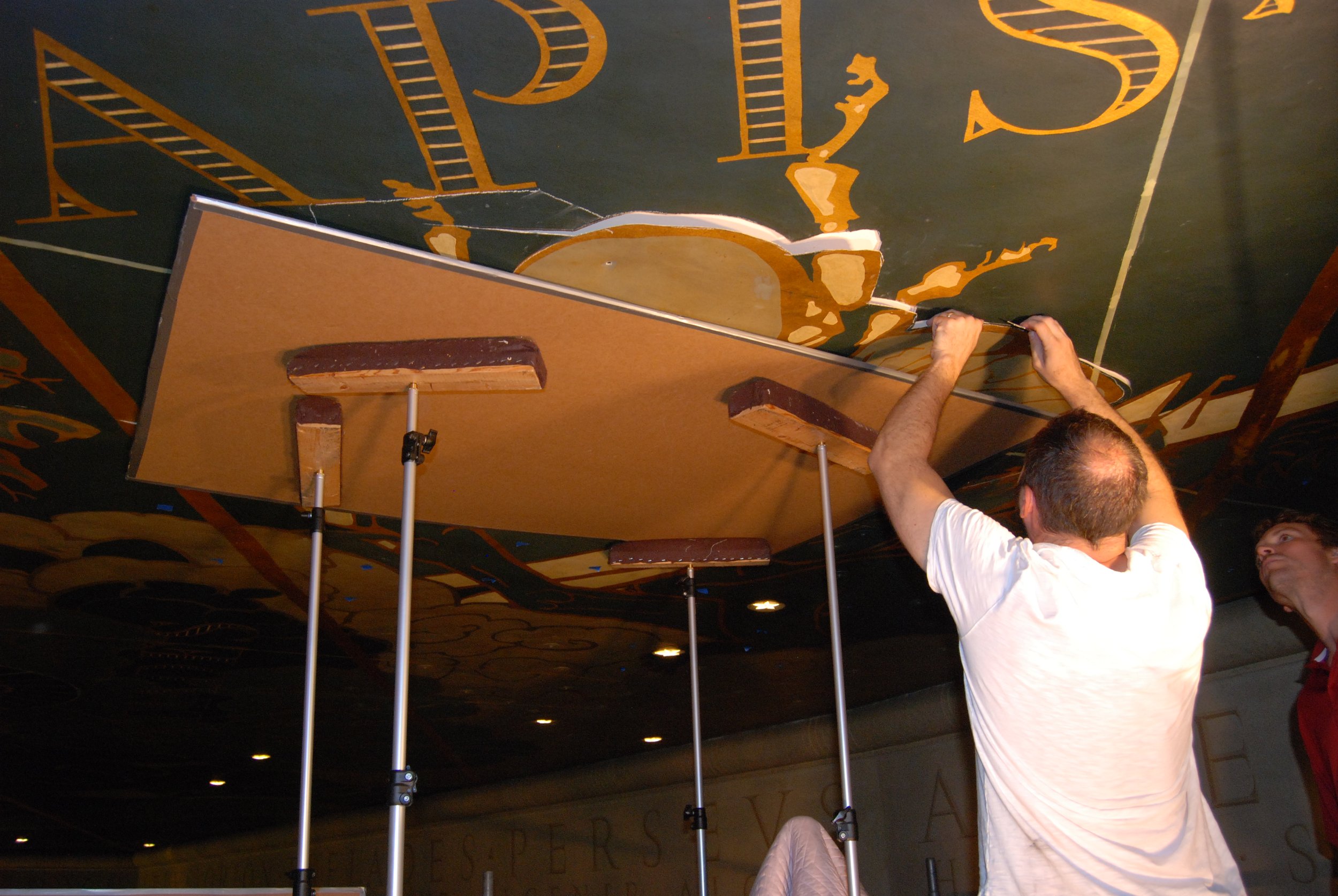Commonwealth of Pennsylvania’s The Forum - Emergency Conservation
Condition of the Ceiling Murals
Image - Scaffold from floor level
In 2010 the Department of General Services issued an emergency contract for conservation because water had damaged the ceiling murals. Leaking HVAC condensate pans and roof drains, and condensation in the un-insulated unheated space above the ceiling had caused the painted canvas on the ceiling to delaminate. The purpose of this contract was to perform emergency temporary reattachment of the delaminating, torn or falling painted canvas so that it is not further damaged until critical emergency repairs can be made to eliminate the water infiltration above the ceiling. As an integral part of this contract, each damaged area of the ceiling was professionally examined to ascertain the current extent of damage. Original construction techniques and materials were documented along with evidence of past conservation or restoration processes in order to better understand the current condition of the ceiling. This enabled us to formulate an appropriate triaged plan for this emergency conservation repair.
Set-Up
Image - View of scaffolding from mezzanine
During this contract, four 40’ high scaffold towers (30’ x 30’) were erected under areas where the painted ceiling canvas was delaminating from the plaster ceiling. Because of the extreme health hazard of white lead adhesive holding these canvases to the ceiling, containment areas were erected on each tower during phases of the treatment that involved consolidation or removal of the lead.
Containment area
Temporary Supports
Image - Cleat being installed
In most instances the canvas was temporarily re-secured to the ceiling using 3” round stainless steel washers and toggle bolts. Several hundred of these cleats were installed from 1’ to 3’ apart depending on how the canvas was detached such as the heavily quilted section seen below.
(continued)
Each of the cleats were inpainted to match the surrounding original paint (with its now discolored varnish coating). These repairs are only meant to save the artwork from continuing water leaks and condensation. The artwork cannot be permanently corrected until the massive undertaking of roof, drainage and HVAC condensation issues can finally be financed and bid out.
Image - Round cleats installed to support canvas
John Hartmann points to a tear caused by weight of failing lead adhesive on canvas
Tears & Lifting Seams
Image - Before treatment lifting seams around Bootes’ head
The reverse of the canvas and ceiling were vacuumed and sealed with a synthetic varnish. Then a thermoplastic adhesive was liberally applied to both surfaces and allowed to dry. The canvas was attached to the ceiling with the aid of a heated tacking iron.
Some lifting seams were tacked back into place using varnish coated iron tacks. In some instance, this was a less invasive and more reversible and temporary means of attachment for smaller areas of delamination than using a thermoplastic adhesive.
Filling & Inpainting
Image - After Treatment view from the floor
Filling and inpainting of losses were only done where damage was visible from the floor below because these temporary repairs will need to be taken out and properly conserved in the future when complete conservation of the ceiling is undertaken.
The Bee
Image - The Bee mural being removed from the ceiling
During this project, artwork above one scaffold tower was found to be so compromised that we requested a change in project scope to remove a 20’ x 20’ section of canvas in order to remove the white lead from the back of the canvas, remove the varnish, and reattach to the ceiling. Because of the extreme weight of the lead on this canvas section (200 to 300 pounds) it was jointly determined that the canvas could be cut into sections along design elements allowing for safe removal from the ceiling and lowering to the ground.
(continued)
Approximately 170 sq.’ of ceiling murals were removed for conservation. This large section was removed in 6 pieces because of the weight of the white lead adhesive. All removed canvas sections were transported to our conservation facility in Carlisle, PA where it was cleaned, removed of varnish and lead, filled, inpainted, and a new coating of varnish was applied.
Image - Mural successfully removed from the ceiling
Reinstallation
Image - After treatment of the Bee reinstalled
Adhesive was added to the canvas reverse side in preparation for reattachment to the ceiling in the Forum. Adhesive was also added to the ceiling and allowed to dry. Heat from a hot air gun was used to reactivate the adhesive on both the ceiling and canvas allowing for a solid reattachment.












